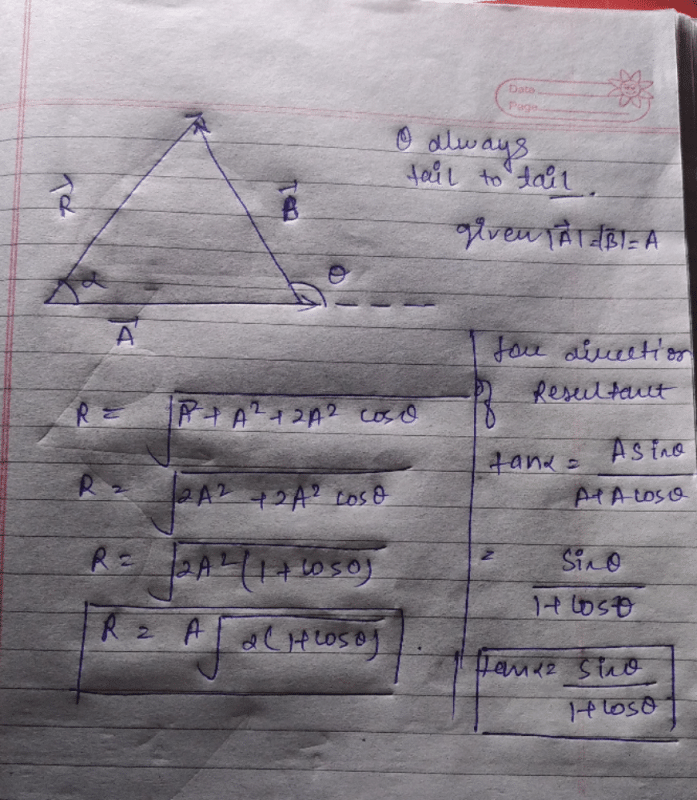NEET Exam > NEET Questions > Two vectors of equal magnitude A make an angl...
Start Learning for Free
Two vectors of equal magnitude A make an angle theta with each other .find magnitude of resultant and direction of resultant?
Most Upvoted Answer
Two vectors of equal magnitude A make an angle theta with each other ....
Problem: Two vectors of equal magnitude A make an angle theta with each other. Find the magnitude of the resultant and direction of the resultant.
Solution:
Step 1: Draw the diagram showing the two vectors A making an angle theta with each other.
Step 2: Find the horizontal and vertical components of each vector. Since the vectors are of equal magnitude, their horizontal and vertical components will also be equal.

Step 3: Add the horizontal components and vertical components of each vector separately to find the total horizontal and vertical components.
Total horizontal component = 2A cos(theta)
Total vertical component = 2A sin(theta)
Step 4: Use the Pythagorean theorem to find the magnitude of the resultant.
Magnitude of resultant = sqrt[(total horizontal component)^2 + (total vertical component)^2]
= sqrt[(2A cos(theta))^2 + (2A sin(theta))^2]
= sqrt[4A^2(cos^2(theta) + sin^2(theta))]
= 2A
Step 5: Find the direction of the resultant by using the tangent function.
tan(theta) = total vertical component/total horizontal component
tan(theta) = 2A sin(theta)/2A cos(theta)
tan(theta) = tan(theta)
Therefore, the direction of the resultant is the same as the direction of the vectors, which is theta.
Final Answer: The magnitude of the resultant is 2A and the direction of the resultant is theta.
Solution:
Step 1: Draw the diagram showing the two vectors A making an angle theta with each other.
Step 2: Find the horizontal and vertical components of each vector. Since the vectors are of equal magnitude, their horizontal and vertical components will also be equal.

Step 3: Add the horizontal components and vertical components of each vector separately to find the total horizontal and vertical components.
Total horizontal component = 2A cos(theta)
Total vertical component = 2A sin(theta)
Step 4: Use the Pythagorean theorem to find the magnitude of the resultant.
Magnitude of resultant = sqrt[(total horizontal component)^2 + (total vertical component)^2]
= sqrt[(2A cos(theta))^2 + (2A sin(theta))^2]
= sqrt[4A^2(cos^2(theta) + sin^2(theta))]
= 2A
Step 5: Find the direction of the resultant by using the tangent function.
tan(theta) = total vertical component/total horizontal component
tan(theta) = 2A sin(theta)/2A cos(theta)
tan(theta) = tan(theta)
Therefore, the direction of the resultant is the same as the direction of the vectors, which is theta.
Final Answer: The magnitude of the resultant is 2A and the direction of the resultant is theta.
Community Answer
Two vectors of equal magnitude A make an angle theta with each other ....

Attention NEET Students!
To make sure you are not studying endlessly, EduRev has designed NEET study material, with Structured Courses, Videos, & Test Series. Plus get personalized analysis, doubt solving and improvement plans to achieve a great score in NEET.

|
Explore Courses for NEET exam
|

|
Similar NEET Doubts
Two vectors of equal magnitude A make an angle theta with each other .find magnitude of resultant and direction of resultant?
Question Description
Two vectors of equal magnitude A make an angle theta with each other .find magnitude of resultant and direction of resultant? for NEET 2024 is part of NEET preparation. The Question and answers have been prepared according to the NEET exam syllabus. Information about Two vectors of equal magnitude A make an angle theta with each other .find magnitude of resultant and direction of resultant? covers all topics & solutions for NEET 2024 Exam. Find important definitions, questions, meanings, examples, exercises and tests below for Two vectors of equal magnitude A make an angle theta with each other .find magnitude of resultant and direction of resultant?.
Two vectors of equal magnitude A make an angle theta with each other .find magnitude of resultant and direction of resultant? for NEET 2024 is part of NEET preparation. The Question and answers have been prepared according to the NEET exam syllabus. Information about Two vectors of equal magnitude A make an angle theta with each other .find magnitude of resultant and direction of resultant? covers all topics & solutions for NEET 2024 Exam. Find important definitions, questions, meanings, examples, exercises and tests below for Two vectors of equal magnitude A make an angle theta with each other .find magnitude of resultant and direction of resultant?.
Solutions for Two vectors of equal magnitude A make an angle theta with each other .find magnitude of resultant and direction of resultant? in English & in Hindi are available as part of our courses for NEET.
Download more important topics, notes, lectures and mock test series for NEET Exam by signing up for free.
Here you can find the meaning of Two vectors of equal magnitude A make an angle theta with each other .find magnitude of resultant and direction of resultant? defined & explained in the simplest way possible. Besides giving the explanation of
Two vectors of equal magnitude A make an angle theta with each other .find magnitude of resultant and direction of resultant?, a detailed solution for Two vectors of equal magnitude A make an angle theta with each other .find magnitude of resultant and direction of resultant? has been provided alongside types of Two vectors of equal magnitude A make an angle theta with each other .find magnitude of resultant and direction of resultant? theory, EduRev gives you an
ample number of questions to practice Two vectors of equal magnitude A make an angle theta with each other .find magnitude of resultant and direction of resultant? tests, examples and also practice NEET tests.

|
Explore Courses for NEET exam
|

|
Suggested Free Tests
Signup for Free!
Signup to see your scores go up within 7 days! Learn & Practice with 1000+ FREE Notes, Videos & Tests.

























